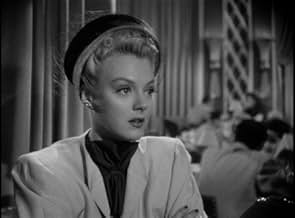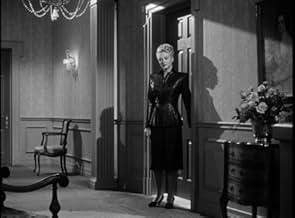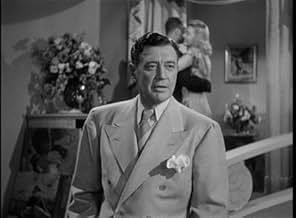Un artista casado con una mujer rica y enferma tiene una aventura con una de sus modelos. Su mujer se entera y le amenaza con excluirle de su testamento. Para quedarse tanto con el dinero co... Leer todoUn artista casado con una mujer rica y enferma tiene una aventura con una de sus modelos. Su mujer se entera y le amenaza con excluirle de su testamento. Para quedarse tanto con el dinero como con la chica, empieza a envenenar a su mujer.Un artista casado con una mujer rica y enferma tiene una aventura con una de sus modelos. Su mujer se entera y le amenaza con excluirle de su testamento. Para quedarse tanto con el dinero como con la chica, empieza a envenenar a su mujer.
- Dirección
- Guión
- Reparto principal
- George
- (sin acreditar)
- Messenger Boy
- (sin acreditar)
- Artist
- (sin acreditar)
- Henry Loring
- (sin acreditar)
- Whistler
- (sin acreditar)
- Jorgensen
- (sin acreditar)
- McLaren aka Mac
- (sin acreditar)
- Butler
- (sin acreditar)
- Girl
- (sin acreditar)
- Detective Lieutenant
- (sin acreditar)
- Girl
- (sin acreditar)
Reseñas destacadas
This is a tale about a mediocre middle aged artist, (Richard Dix as Ralph Harrison) married to a middle-aged wealthy wife (Mary Currier as Edith Harrison). The first scene sets us up for the macabre nature of the tale to come. A woman is ordering an expensive headstone - even in 1946 it will cost five thousand dollars . The stonemason is telling her it will take three months to build such an expensive monument. She says that is OK. Then she gives the name to be put on the headstone - her own. You see, Edith is quite ill with a bad heart and has only months to live and she knows it.
Someone else here mentioned this as the tale of "the inconvenient wife", but it is not at all clear what Ralph's true feelings are for his wife, at least in the beginning. For sure he likes not having to sell sketches in the park, to be able to have his own studio and dabble even though he has no talent, and to entertain his "friends" who are actually just a bunch of parasitic hangers on. However, he seems genuinely troubled and saddened by the doctor's news that his wife has only weeks or months to live. His great misfortune is to befriend ace grifter Kay Morrell just to have someone to talk to during his time of trouble with his wife tied to a sick bed, and then he falls in love with her.
Ralph decides he really wants Kay, Kay really only likes Ralph's money, and Ralph really likes his money too, and he loses that if he divorces Edith. Normally he could just wait out Edith's illness to its inevitable conclusion, but then a monkey wrench is thrown into his plans - a young hot-shot doctor devises a state of the art treatment plan and Edith now has a second lease on life. I'll let you watch for yourself and see how all of this plays out.
This particular whistler entry is the essence of noir - an average man who is on an average man's path until something unexpected comes along, and suddenly that forbidden fruit just looks to good to pass up. Surely he can get away with a bite out of that fruit just once...or not.
Like I said earlier, Dix did an outstanding job in this one. You never really know what his true feelings are deep in his heart, since he plays his cards close to his vest in his role as Ralph and he is fascinating to watch. Kudos also go out to Claire Du Brey who has her Mrs. Danvers like role down pat as the loyal servant of Edith, and also to Leslie Brooks as Kay Morrell who is beautiful and cold as ice as the femme fatale. A highly recommended little B noir.
Nonetheless, the story keeps us watching. As usual we can't be sure how events will turn out since Dix's character is as morally compromised as in the other entries. Unlike other Hollywood films of that era, there is no one to root for as the plot unfolds. Thus, it's the story itself that holds our interest, and not the more predictable question of how a hero will triumph. Fortunately, the ending comes up with the usual fine touch of irony that fans expect.
There's an expertly shaded performance by Mary Currier as Dix's star-crossed wife. Watch the subtlety of her expressions as she learns about her wayward husband. The series itself did not depend on subtle acting-- and certainly Dix doesn't manage the Lothario role very well. Nonetheless, Currier delivers an A-grade performance. (In passing-- I expected the screenplay to develop the scheming relationship between blonde model Kay and her effete boyfriend Jim more fully than it did. That could have set up an interesting dynamic of those schemers competing against another schemer, Dix.) Anyway, stylish or not, this remains a very watchable hour of frustrated passion and the hand of fate.
Here he plays a less than admirable character. He is a painter. Amazingly, the painting of his that we first see is pretty decent. So often, even in the toniest of A-pictures, paintings by supposedly great artists looked like the work of quick-sketch artists or Sunday painters.
The film opens with a stylishly noirish woman buying her own tombstone. Everything bout this film has the marvelous dark look of a film noir. Or of an Edward Hopper paintings. The scenes look especially like book jackets from the time.
And the female lead looks right off the cover of some true-crime book. Wow, she looks both right and beautiful! And she -- Leslie Brooks -- is a fine actress too. (Intriguingly, she looks like the same studio's biggest star ten years hence: Kim Novak.)
The whole series is entertaining, even the final film, which does not have Dix in it.
One problem I encountered and others may as well: Clearly the movies were based on a radio program of their time. I have never heard that program, though. I get the idea that the Whistler is an omniscient criminologist who either has no bodily image or, like Lamont Cranston of "The Shadow," can make himself invisible.
Guess I will try to track some tapes of the series down. In the meantime, do yourself a favor and search out these films. They're all good. A couple, like this one, are very good.
voice-over narration, but the "star" of the films is Richard Dix, who plays a different role in each--some heroic, some cowardly, some honorable, some not so honorable. This must have been satisfying to Dix, since it gave him regular work AND allowed him to show his talent in a wide variety of roles. This particular entry gives Dix a complex role, as an artist married to a rich woman whose financial support allows him to continue his work. The plot is more complex than the synopsis suggests, and there are a number of twists and turns throughout, giving the film the feel of an episode of Alfred Hitchcock Presents. The "femme fatale" in this film is played by Leslie Brooks, who took this kind of role even further in the great BLONDE ICE two years later. Director George Sherman did a lot of exciting films at Republic prior to this film at Columbia, including many entries in the Three Mesquiteers series, and went on to do many more films, including episodes of such classic TV shows as Rawhide and Naked City. The centerpiece of the film, though, is Richard Dix, an actor of great presence (it's fair to say that Gary Cooper was influenced by Dix)and subtlety. SECRET OF THE WHISTLER would be a good introduction to this series, and it should appeal to any fan of INNER SANCTUM, THRILLER, ALFRED HITCHCOCK PRESENTS, etc. Most of the other films in the series are worth checking out also. Perhaps sometime in the future Columbia could do a DVD boxset of the Whistler films the way Universal is doing the Francis and Ma&Pa Kettle films? And after that, perhaps they could reissue the Boston Blackie films?
Again the Whistler just walks around as Narrator. He doesn't get involved in the plot.
The series stars Richard Dix. Here he plays Ralph Harrison, a not great artist who lives off his sick wife's (Mary Currier) money. In the beginning of the film, we see her ordering her own gravestone!
Edith Harrison has a terminal heart condition. When her husband meets model Kay Morrell (the very pretty Leslie Brooks), he falls in love with her. However, a new doctor has gotten Edith out of her sickbed and ready to live again.
Edith goes to her husband's studio to surprise him. She's the one surprised as she overhears him declaring his love for Kay and saying Edith will be gone soon. In fact, he decides to help her along.
Richard Dix is an actor I have a hard time with. I find his acting not good, along with his hairpiece, and he's quite rigid. Sometimes he's a good guy in the Whistler series; here he's a bad one. There's a twist at the end.
This is the best Whistler I've seen.
¿Sabías que...?
- CuriosidadesThis is the penultimate film of Richard Dix, being 99th out of the 100 he made.
- PifiasAfter Harrison's servant discovers Mrs Harrison lying on the floor, using the bedroom phone tells Loring she hangs up and then calls the doctor. But, the phone downstairs that she originally answered when Loring called is still off the hook and therefore she would not be able to make the call.
- Citas
Ralph Harrison: What's the matter, Darling?
Edith Marie Harrison: Stop acting, Ralph. There's nothing quite so contemptible as a hypocrite.
- ConexionesFollowed by The Thirteenth Hour (1947)
- Banda sonoraPut The Blame On Mame
Written by Allan Roberts and Doris Fisher
Played during the party in Ralph's studio
Selecciones populares
Detalles
- Fecha de lanzamiento
- País de origen
- Sitios oficiales
- Idioma
- Títulos en diferentes países
- Секрет Свистуна
- Empresa productora
- Ver más compañías en los créditos en IMDbPro
- Duración1 hora 5 minutos
- Color
- Relación de aspecto
- 1.37 : 1
Contribuir a esta página
































